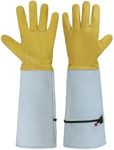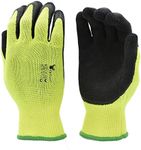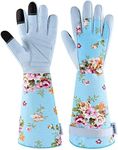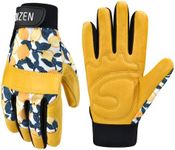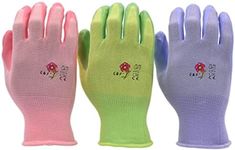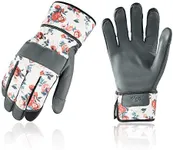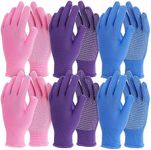Buying Guide for the Best Womens Gardening Gloves
Choosing the right gardening gloves is essential for any gardening enthusiast. The right pair of gloves can protect your hands from thorns, blisters, and dirt while providing comfort and dexterity. When selecting gardening gloves, consider the type of gardening you will be doing, the climate, and your personal comfort preferences. Here are some key specifications to help you make an informed decision.MaterialThe material of gardening gloves is crucial as it determines durability, comfort, and protection. Common materials include leather, cotton, and synthetic fabrics. Leather gloves are durable and provide excellent protection against thorns and rough surfaces, making them ideal for heavy-duty gardening. Cotton gloves are lightweight and breathable, suitable for light gardening tasks and warm weather. Synthetic gloves, often made from materials like nylon or polyester, offer a balance of durability and flexibility, and some are even waterproof. Choose the material based on the type of gardening you do and the level of protection you need.
Fit and SizeA proper fit is essential for comfort and functionality. Gloves that are too tight can restrict movement and cause discomfort, while gloves that are too loose can slip off or make it difficult to handle tools. Most gloves come in small, medium, and large sizes, but some brands offer more specific sizing. To find the right fit, measure the circumference of your hand around the knuckles and compare it to the sizing chart provided by the manufacturer. Consider trying on different sizes to ensure a snug but comfortable fit that allows for dexterity.
GripGrip is important for handling tools and plants securely. Gloves with textured palms or fingers provide better grip, which can be especially useful when working with wet or slippery materials. Some gloves have rubberized or silicone coatings on the palms and fingers to enhance grip. If you frequently handle tools or work in wet conditions, look for gloves with enhanced grip features to prevent slipping and improve control.
DurabilityDurability is a key factor, especially if you engage in heavy-duty gardening tasks. Durable gloves are made from high-quality materials and reinforced stitching to withstand wear and tear. Leather gloves are known for their durability, while synthetic gloves with reinforced palms and fingers can also offer long-lasting performance. If you do a lot of digging, pruning, or handling rough materials, prioritize gloves that are designed to be durable and resistant to punctures and abrasions.
Water ResistanceWater resistance is important if you garden in wet conditions or need to handle damp soil and plants. Some gloves are made from waterproof materials or have a water-resistant coating to keep your hands dry. Waterproof gloves are typically made from synthetic materials like nylon or polyester with a waterproof membrane. If you often work in wet environments, choose gloves with good water resistance to keep your hands dry and comfortable.
BreathabilityBreathability is important for comfort, especially in warm weather. Breathable gloves allow air to circulate, preventing your hands from becoming sweaty and uncomfortable. Cotton gloves are naturally breathable, while some synthetic gloves have mesh panels or ventilation holes to enhance airflow. If you garden in hot climates or during the summer, look for gloves with good breathability to keep your hands cool and dry.
FlexibilityFlexibility is important for tasks that require dexterity, such as planting seeds or handling delicate plants. Flexible gloves allow for a greater range of motion and make it easier to perform precise tasks. Synthetic gloves are often more flexible than leather gloves, and some have added stretch materials like spandex for improved flexibility. If you need to perform detailed work, choose gloves that offer good flexibility without compromising on protection.

